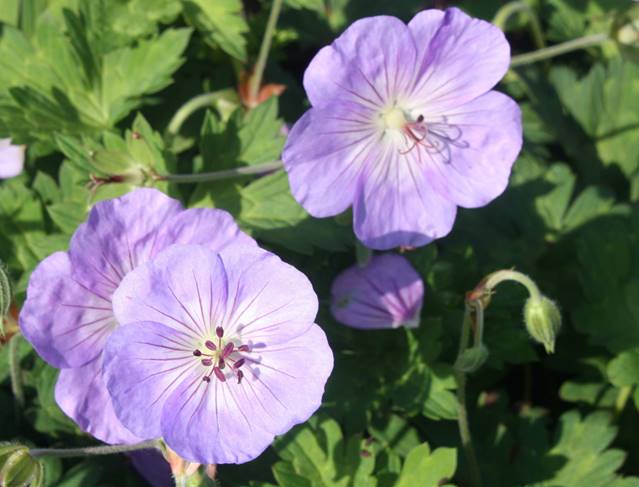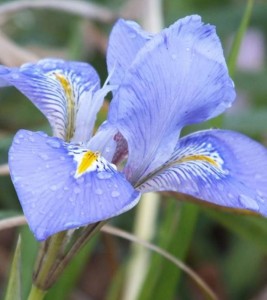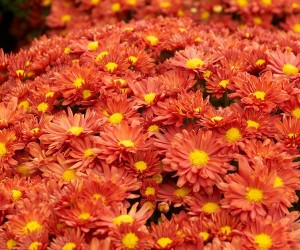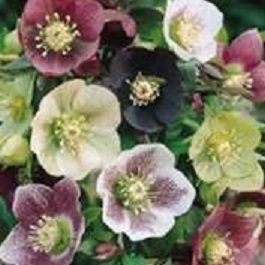This Geranium is a mutation from Geranium Rozanne found by Jan Schuiver at Jeddeloh Nurseries in Germany because Geranium Rozanne has EU PBR. Azure Rush is considered an EDV of Rozanne.
Geranium ‘Azure Rush’ has a lighter flower colour compared to Rozanne and is more of a compact plant, it retains though, the same flowering period as Rozanne.
Azure Rush is good in borders and patio pots so are just as versatile as Rozanne.
I trialled the plant in the trial garden and my own patio area prior to it being introduced.
So now is the time to be busy looking at your flowering plants and those that are flowering from your selections and breeding work and making further crosses and selections.
As you can see from the picture above that new cultivars can also be found in the garden and growing areas. You need to check though if you find one if it is from a protected plant the rights to the new cultivar may belong to the breeder of the original plant.
Trialling plants can be a long process but its all part of the new plant development and plant breeding process.
It is good to look at plants in your own garden, looking for improvements that may be possible.
You see with the Geranium, by getting a compact flowering plant it makes the plant more fitting for today’s market and for growers more plants can be transported on a lorry in flower as its shorter so it’s a good grower’s plant. Sometimes as with Geranium ‘Azure Rush’ it’s a lucky find!
You need to keep records of any crossings you make and any different plants that you find.
Get the camera ready to take photos to record your work.
For developing your new plant breeding selection or new plant discovery I can offer full trialling and a new plant development service. More details are available on my website.
AUGUST GARDENING
Well as we go into August the weather after a very hot July is now variable with some strong winds and rain forecast in a few days, in my area at my garden we have had some rain but also some very hot days during July so pots have needed water every day whether its rain or shine.
Plants to look for in August
- Anthemis
- Buddleja – all gardens should have one
- Dahlia
- Geraniums – Patricia, Rozanne, Azure Rush
- Heliopsis
- Helenium
- Helianthus – Sunflowers
- Penstemon
- Salvia
- Rudbeckia
- Caryopteris
- Hibiscus
- Roses
You will need to keep all baskets and tubs watered and checked each day.
Apply liquid feed regularly once a week is ideal this will keep your containers looking fresh, deadheading also helps to prolong flowering.
Look out daily for slugs and snails check your local garden centre for best controls, an idea I have seen is to place an old roof tile on the ground, snails go under here during daytime just turn over and pick them off each day.
Coleus plants make ideal patio plants. There are many new varieties with many different leaf colour combinations.
Combination planting in containers is becoming popular lookout for them in your local garden centre, look for some last-minute bargains to fill up spaces in the garden and rejuvenate tubs and baskets.
Ideal plant for container planting is Geranium ‘Azure Rush’.
When planting containers use a gel in the compost. This will help retain and save water, always water in the late evening even better is to use trickle/drip irrigation on a timer.
Regular weeding and hoeing, whenever you can, will keep weeds under control.
Deadheading will help to prolong flowering, and for some plants like Aquilegia cut back after flowering to prevent seeding in the garden, otherwise, they tend to take over.
Deadheading Roses will extend the flowering period and will encourage re-flowering to continue.
Cut back Digitalis and Verbascum, can encourage some re-flowering.
Take semi-ripe cuttings now.
Fill any gaps in borders with last-minute bedding plant offers from the garden centre or online.
You can trim evergreen hedges now but avoid during very hot weather and drought conditions.
Look out for Aphids and other pests, black spot on Roses, check with the local garden centre for best controls.
If you grow Lilies pick off any Lilly beetle seen.
Look out for Vine Weevil damage, the damage shows when plants start to wilt, on inspection roots will have been badly eaten
You may also see white c shaped larvae, apply a biological control, plants in containers are unlikely to recover.
Sedums and Geraniums can be badly affected.
Mow the lawn regularly, mulch clippings or recycle, keep edges neat, don’t mow too short during dry periods, don’t worry to much about brown lawns they will soon come back at the first rain.
If your lawn is very dry at the moment, don’t cut it, leave until there has been a good rain the grass will come back.
Apply summer fertilizer, follow instructions, slow-release is best, do not apply in drought conditions, if using feed and weed avoid getting onto ornamental plantings as it will cause damage.
Use a selective weed killer to kill weeds, not the grass, better than using feed and weed most professionals do it this way.
If you have wildflowers in lawn and want to keep them then do not use feed and weed.
During a dry period if you are watering the lawn do this at night when evaporation is low, better still don’t, the lawn will come back use water wisely.
If you have a pond then keep water circulating, if you have a fountain or waterfall keep running during the night during hot periods to keep oxygen levels up. Clean filters as needed, remove blanket weed and skim off floating weeds such as duckweed, feed fish as needed.
Remove any debris leaves etc, this reduces toxin build-up.
Open greenhouse and increase ventilation on sunny days, extra shading like shade paint applied to outside may be needed during hot periods, don’t let greenhouse get too hot.
Damp down the floor of the greenhouse on hot days, this will control Red Spider mite.
Tomatoes will need tying in as they grow and remove the side shoots that grow from leaf joints when flowering you may need to give plants a little shake to help will pollination.
Give plants space as they grow.
You should be starting to see fruit forming now, important to ventilate well during hot sunny days.
Feed tomatoes with Tomorite as the fruit starts to form. Apply feed with a watering can at the base of the plant, once a week is ideal.
Tie in roses and other climbers.
Check for pests like Aphids, red spider mite, whitefly regularly. Biological controls are available, look online.
Pick off any dead leaves, keep floor and pathways free of plant debris this will assist with pest and disease control.
In the vegetable garden, continue weekly sowings of lettuce, radish, peas etc to get a continuity of crops.
Potatoes should be well underway, continue to harvest as needed.
Support peas as needed.
Harvest Rhubarb, but leave 2 thirds to grow on.
You may need to cover some plants to protect against bird damage, fleece is ideal.
Cover carrots to control carrot fly.
Plant out leeks and cabbages.
Take time to relax in the garden at some time each daytime for barbecues and enjoying the fruits of your hard work.
The garden should be an extension of your house, an extra room if you like and now with a little work each day you can keep it looking at its best.




















